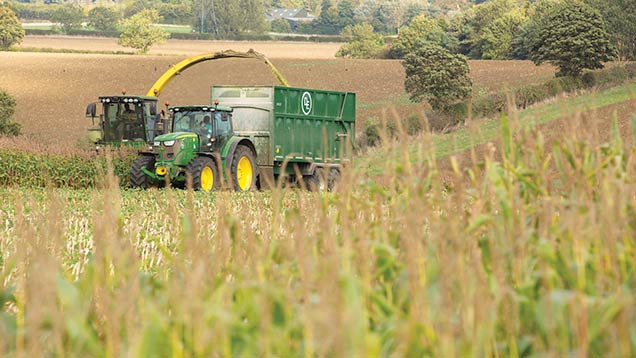Couple cover crops with maize to reduce nutrient losses
 © Tim Scrivener
© Tim Scrivener Undersown cover crops are helping Danish farmers meet the environmental and legislative challenges associated with growing maize.
Researcher Hans Spelling Oestergaard, from Danish advisory group Seges, explained that cover crops are being used in Denmark to reduce leaching and erosion losses, and help growers to comply with legislation.
“In Denmark, all crops have a specific nitrogen quota, which can’t be exceeded. Each farm also has to have a minimum area of cover crops – the size of which depends on whether they have livestock or not,” he said.
Those areas are 14% of the farmed area for mixed farms, or 10% if the unit is all arable. “Without enough area in cover crops, growers lose some of their nitrogen quota,” Mr Oestergaard added.
The nitrogen quota for maize is 157kg/ha of nitrogen on irrigated sandy soil, and 144kg/ha without irrigation. Most of this comes from manures, but some is from bagged fertiliser placed at sowing.
Leaching is a problem both in the spring and the autumn, especially on light, sandy soils when growing maize.
“While there are techniques that can be used in the spring to reduce this, such as nitrification inhibitors and later applications, cover crops are the best solution for the autumn and winter period,” he added.
Screening of different cover crops has taken place at Seges. The best cover crops are those that germinate before the maize closes across the rows at the beginning of July, but that do not interfere with the crop, he said.
If sown too early, before the middle of June, species such as perennial ryegrass, cocksfoot, tall fescue and chicory can adversely affect maize yields, especially on poorer soils.
“Chicory in particular has to be sown late. It grows well in the shadow of the maize crop,” Mr Oestergaard said.
However, chicory has a deep rooting advantage and in a mixture with perennial ryegrass, these two are a really good combination for late sowing.
His tips for getting cover crops established in maize included sowing them at a 1-2cm depth, into a firm seed-bed, with 20cm between the cover crop and the maize plants.
“Strip sowing in three rows, to a precise depth, was the most successful. Broadcasting before hoeing was the least good,” he said.
Maize in the UK
Undersowing grass is the way forward for sites at risk from soil erosion, said Simon Draper of the Maize Growers Association.
“Sow with grass at the 6-8 leaf stage of maize. Use half the normal seed rate, as you don’t want too much grass,” he added.
Slow growth is useful, as then the grass won’t compete with the maize but remains there when the maize is cleared in September.
Soil moisture is important for good germination. “Broadcasting is easy, but can be very variable with soil moisture. Ryegrass is the cheapest option to go for,” he added.
Eyespot ratings
Maize varieties severely infected with eyespot will lose between 1-3t/ha of yield at harvest, reported Jane Thomas of crop consultancy Niab Tag.
While the majority of varieties have a 5 rating for the disease on the crop’s Descriptive List, there are encouraging signs that six of the new entries in 2014 showed levels similar to that of Salgado, which has an 8.
“At this level, the disease establishes, but doesn’t increase,” she said.
Eyespot information can be used in agronomy guidelines. Very susceptible varieties aren’t suitable for high-risk situations and should be harvested early, before the foliage is killed. Any infected debris should be ploughed, she added.
Insect pests
Maize growers must be alert to the signs of the European corn borer and the Western corn rootworm, warned James Bell of Rothamsted Research.
Both pests can have devastating effects, which is why monitoring and surveillance are so important, he stressed.
“The corn borer, which is a moth, was first discovered in the UK in 2012 in Devon, but has since been found in Hampshire, Sussex and Essex,” he added.
The western corn rootworm is a leaf beetle, which hasn’t been recorded here since 2007. But growers should remain vigilant, because it can cause extensive damage.
If suspected, samples of larvae or adults can be sent to Rothamsted for identification. “Both pests struggle under rotation, so try to avoid growing continuous maize,” he added.
All contributors were speaking at last month’s Maize Growers Association conference.

